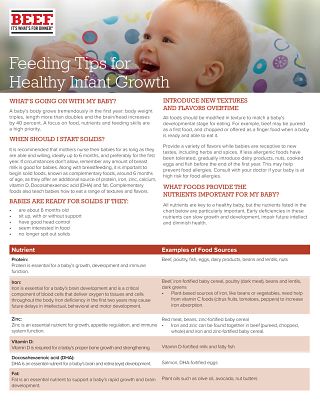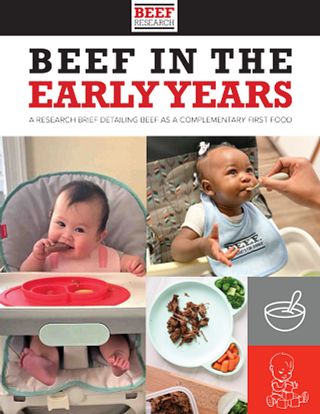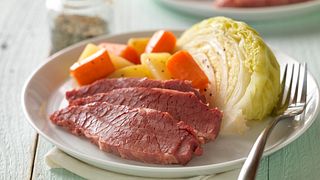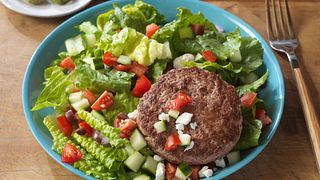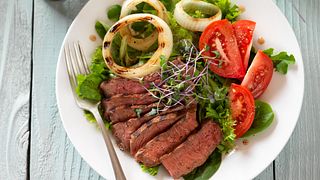Nutrition Through the lifecycle
Humans generally require the same nutrients throughout life, although the amounts of certain nutrients vary somewhat depending on the stage of life. Infancy, childhood and adolescence – as well as pregnancy and lactation – are periods of anabolism, where muscles, tissues and bones are growing more rapidly than they are breaking down. By adulthood things stabilize, with growth and breakdown occurring at the same rate (homeostasis). In older age (in women, this is often marked by the onset of menopause), bodies enter a more catabolic stage, where muscle and tissue breakdown tends to occur, with little or no growth to replace losses. Eating beef can help to meet nutrient needs during each of these life stages.
Infancy
The early years are marked by a period of exponential growth. During this time, birth weight tends to double by 4 months of age, and triples by 12 months; birth height doubles by age 5.1,2 Babies’ brains are also growing at a rapid pace, laying down neural pathways and making new neural connections.3 Protein is essential for growing bodies, and the brain relies on several vitamins and nutrients for healthy growth.4
Infants 6 to 12 months of age who are exclusively breastfed are at a higher risk for falling short of certain key nutrients like iron and zinc due to the extraordinary requirements for growth.5 A good dietary source of iron and zinc is needed by 6 months of age, as needs cannot be met by breast milk alone. Among infants and children worldwide, iron is the most common nutrient deficiency.6,7 Heme iron, or the kind found in animal foods, is the type of iron the body uses to transport oxygen to cells. Zinc is an essential mineral that supports metabolism of macronutrients for energy, boosts immunity, helps the body heal wounds, and maintains normal blood glucose levels.8 Adequate intake of iron and zinc during this period is critical to protect against deficiencies, which are associated with long-lasting negative effects on a child’s development, learning, behavior and growth.9
Complementary foods, that is, foods other than breast milk or infant formula, are typically introduced around 6 months of age and are essential to ensuring adequate nutrition as the baby grows.9-11 Infants who are not introduced to complementary foods when developmentally ready may reject foods introduced at a later age, and may also consume an inadequate variety and amount of food to meet their nutritional needs.9-11
The American Academy of Pediatrics (AAP) and other nutrition experts note that there is no medical evidence for introducing solids in a specific order. Most often, single-grain, iron-fortified cereals are introduced as a first complementary food; however, the AAP advises that meat, including beef, turkey, and chicken, should be added as early solids to the infant’s diet.9 Beef as a complementary food in infancy and toddlerhood is a good source of heme iron, plus protein, vitamin B12, selenium, zinc and other vitamins and minerals.12-13
Compared to iron-fortified cereals, meats generally contain less iron per serving; however, research has shown that the high bioavailability of iron in meat makes this complementary food more effective in helping to meet iron requirements and prevent deficiency.12
For more information on the new science-based guidance on transitioning infants to solid foods, view the AAP's videos on Baby's First Foods with pediatrician David Hill, MD, FAAP and The Importance of Food Variety with pediatrician David Hill, MD, FAAP.
Adolescence and Adulthood
From childhood and into adolescence and adulthood nutrient needs increase at a similar pace. Adolescent, pre-menopausal, pregnant,14 and lactating women are the exception as they require more daily iron than men of the same age.11 Beef is the number three food source of iron in the American diet following iron-enriched breads and cereals.15 However, the iron in red meat is more completely absorbed by the body than the iron found in bread, cereal and other plant products. Two factors can increase the absorption of iron from plant foods — meat and vitamin C. Meat consumption during a meal has been shown to increase the absorption of plant iron two- to four-fold. This enhancing effect is known as the “meat factor."16 In general, it is recommended to eat a variety of foods to meet nutrient needs and pair iron-enhancing foods with iron-rich foods to increase iron absorption.
In addition to increased needs for iron, pregnant and lactating women require ample protein, folic acid, zinc, choline, vitamin C, and B vitamins. On average, a 3-oz. serving of lean beef is about 150 calories and an excellent source of protein, zinc, vitamin B12, vitamin B6, niacin, and selenium and a good source of phosphorous, choline, iron and riboflavin.13
Older Adulthood
The breakdown of muscle and bone is a natural process of aging. Sarcopenia is a condition associated with a loss of muscle mass and strength in older individuals.17 Prevention is especially important to ensure people can continue to live well and independently since loss of muscle can decrease stamina, lessen the ability to perform daily tasks, and lead to an increased risk of falls and bone fractures. While there is no single cause, insufficient protein intake may be a key contributor to this condition, which can significantly compromise overall quality of life as we age.18
Research has found that eating enough protein-rich foods is essential to help protect lean body mass and prevent sarcopenia. Adults should aim to consume approximately 30 grams of high-quality protein per meal to prevent sarcopenic muscle loss,19 which is well within the current guidelines for protein.
Bones also need enough protein to reach their peak performance. Current evidence shows no adverse effects of higher protein intakes for adults and are considered safe for older adults with healthy kidney function.20-21 A study showed that adults between the ages of 50 and 69 who ate more protein-rich foods, such as beef, had fewer hip fractures resulting from osteoporosis.22 These findings demonstrate the importance of dietary protein for optimal bone health, which can have a significant impact on overall health and independence. Muscle and bone decline may be nature taking its course, but eating adequate protein, including beef, may help to slow the course of nature!
Resources for Health Professionals
The following resources show how beef can make an excellent first food…and a forever food throughout life:
- Feeding Tips handouts: Healthy Infant Growth; Healthy Toddler Growth
- Beef as a first food handout
- Webinar Presentation Slides: Nutrition Strategies for Infants and Toddlers
- Recipes for Infants and Toddlers handout
- Journal Article: Zinc – The Metal of Life, Comprehensive Reviews in Food Science and Food Safety 2014
- Journal Article: Characterization of Dietary Protein among Older Adults in the United States: Amount, Animal Sources, and Meal Patterns, Journal of the Academy of Nutrition and Dietetics 2013 (subscription required)
- Journal Article: Food Group Intake and Micronutrient Adequacy in Adolescent Girls, Nutrients 2012
- Baby's First Foods video with pediatrician David Hill, MD, FAAP
- The Importance of Food Variety video with pediatrician David Hill, MD, FAAP
- Puntis JEL. Clinical evaluation and anthropometry. In: Koletzko, B, ed. Pediatric nutrition in practice. 2nd ed. Karger, NY:2015:6-13.
- Graber EG. Physical Growth of Infants and Children. Merck Manual – Consumer Version, 2017.Available at http://www.merckmanuals.com/home/children-s-health-issues/growth-and-development/physical-growth-of-infants-and-children
- Stiles J, Jernigan TL. The basics of brain development. Neuropsychol Rev 2010;20:327–48.
- Prado EL, Dewey KG. Nutrition and brain development in early life. Nutr Rev 2014;72:267-84.
- Dewey KG. The challenge of meeting nutrient needs of infants and young children during the period of complementary feeding: an evolutionary perspective. J Nutr 2013;143:2050-4.
- Baker RD, Greer FR, Committee on Nutrition American Academy of Pediatrics. Diagnosis and prevention of iron deficiency and iron-deficiency anemia in infants and young children (0–3 Years of Age). Pediatrics 2010;126:1040-50.
- Domellöf M, et al. Iron requirements of infants and toddlers. J Pediatr Gastroenterol Nutr 2014;58:119-29.
- Kaur K, et al. Zinc: The metal of life. Compr Rev Food Sci Food Saf 2014;13:358-76.
- American Academy of Pediatrics. Pediatric Nutrition Handbook. 7th ed. Elk Grove, IL: American Academy of Pediatrics; 2014.
- Pan American Health Organization/World Health Organization. Guiding principles for complementary feeding of the breastfed child. Washington DC: Pan American Health Organization/World Health Organization; 2003.
- U.S. Department of Agriculture, Food and Nutrition Service, Special Supplemental Nutrition Program for Women, Infants, and Children (WIC). Infant nutrition and feeding: A guide for use in the WIC and CSF Programs. Washington, DC: US Government Printing Office, 2009. [FNS-288]
- Krebs NF, et al. Effects of different complementary feeding regimens on iron status and enteric microbiota in breastfed infants. J Pediatr 2013;163:416-23.
- U.S. Department of Agriculture, Agricultural Research Service, Nutrient Data Laboratory. USDA National Nutrient Database for Standard Reference, Release 28 (Slightly revised). Version Current: May 2016.
- Procter SB, Campbell CG. Position of the Academy of Nutrition and Dietetics: nutrition and lifestyle for a healthy pregnancy outcome. J Acad Nutr Diet 2014;114:1099-103.
- O’Neil CE, et al. Food sources of energy and nutrients among adults in the US: NHANES 2003–2006. Nutrients 2012;4:2097–120.
- Hurrell RF, et al. Meat protein fractions enhance nonheme iron absorption in humans. J Nutr 2006;136:2808-12.
- Santilli V, et al. Clinical definition of sarcopenia. Clin Cases Miner Bone Metab 2014;11:177-80.
- Paddon-Jones D, et al. Protein and healthy aging. Am J Clin Nutr 2015;101:S1339-45.
- Paddon-Jones D, Leidy H. Dietary protein and muscle in older persons. Curr Opin Clin Nutr Metab Care 2014;17:5-11.
- Shams-White MM, et al. Dietary protein and bone health: a systematic review and meta-analysis from the National Osteoporosis Foundation. Am J Clin Nutr 2017;105:1528-43.
- Wallace TC, Frankenfeld CL. Dietary protein intake above the current RDA and bone health: A systematic review and meta-analysis. J Am Coll Nutr 2017;36:481-96.
- Wengreen HJ, et al. Dietary protein intake and risk of osteoporotic hip fracture in elderly residents of Utah. J Bone Miner Res 2004;19:537-45.

